Photo
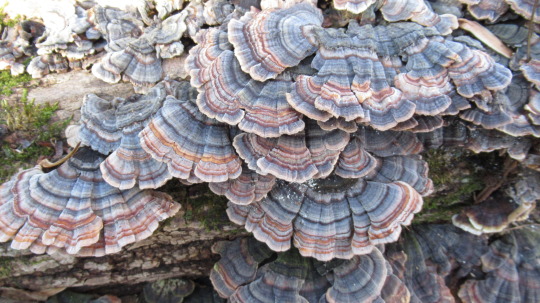

Turkeytail
Trametes versicolor
Turkeytail is a commonly sought after fungi.
Though it isn’t prized for cooking, it’s still foraged as tea, and many people believe turkeytail teas or extractions have various health benefits.
As mushrooming has become somewhat more popular recently, I’ll sometimes come across people interested in finding and identifying wild T versicolor for their own use.
Anyone interested would be happy to learn that this is one of the most easily encountered fungi, at least around where I live in Cleveland, Ohio.
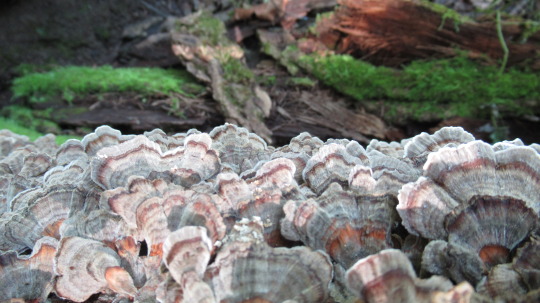

The colorful arrangements that make up the varying concentric zones on these little fan shaped fruiting bodies look like turkey tails.
The species name “versicolor” comes from the color variations to be found both in individual specimens and in various flushes in different environments.
They can come in shades of peaches and cream, greens and grays, brown and tan, or even smoky blue.

They range in size from small and inconspicuous to large and spreading.
They may cluster in little spreads or sheet across entire logs. They are saprobic, growing on dead wood.
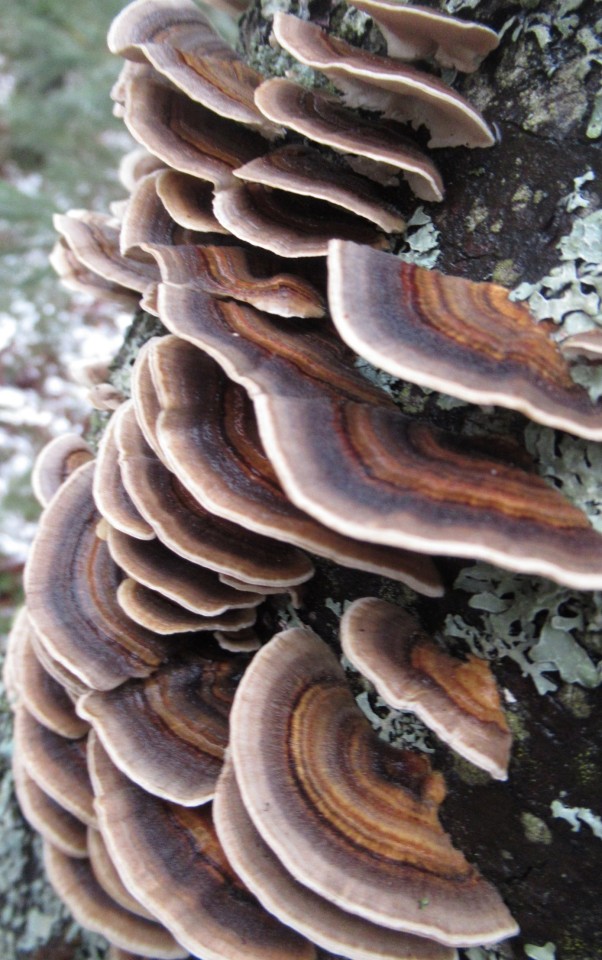
Besides some of their look-a-likes, such as violet tooth or “false” turkeytail Stereum ostrea, T versicolor are probably the fungi I come across most often on my walks.
When you know their habitats, fruiting seasons, and key identifying features, they can be found in practically minutes.
They tend to grow with a bit of fuzz on them, making them somewhat velvety. They are white on the undersides with true pores. This should distinguish it from some of its look-a-likes.
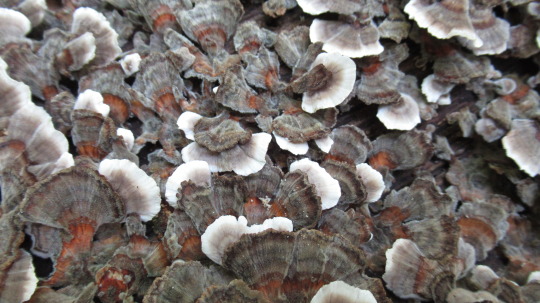
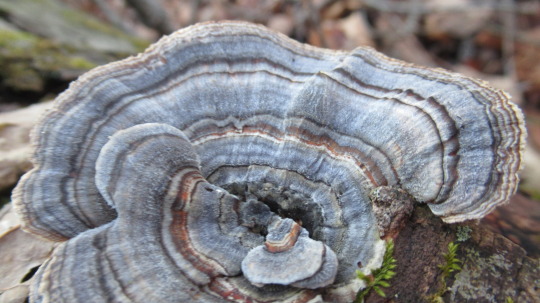
I consider Turkeytail pretty safe for beginners, but you should always do your own research. If you’re just starting out, take the time to get to know these fungi and their look-alikes.
Most fungi which resemble Turkeytail are non-toxic. But you should still be sure of your own IDs if you plan on ingesting any wild fungi.
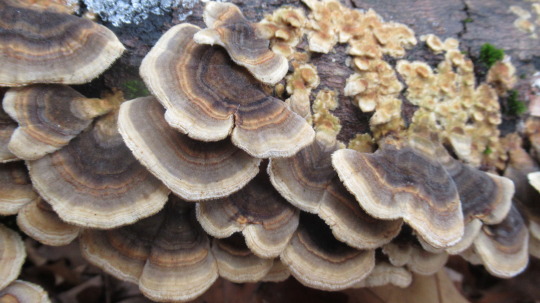
I won’t pretend to be very knowledgeable about their reported health benefits. Certainly, natural diversity is good for any diet. I drink turkeytail tea and prefer it to reishi because I think it tastes better.
I tend to let them grow through summer and harvest in fall or early winter. I think most are unfit to consume after January before a new season begins.
#fungi#mushrooms#turkeytail#hiking#forest#nature#foraging#wildeats#biology#mycology#mycellium#rot#forestfloor#forestcore#fairycore#mushroom photography#fungi photography#life#nature photography#naturecore#mushlove#fantastic fungi#wild#healthy habits#natural foods#species identification#science#bioart
356 notes
·
View notes
Photo


Lemon drop fungi
Bisporella citrina
The disks or cups of B citrina are only a few millimeters across, so it’s no wonder they can be easily missed despite their vibrant color.
They can be typically found on barkless decaying logs or in the cracks where bark is beginning to peel.
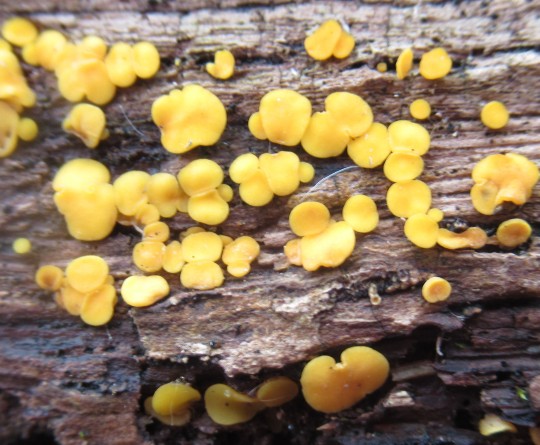
Common names include lemon drops or yellow fairy cups.
Though they might be walked past without a thought, but catch them in sunlight and the color is almost dazzling.
They can be somewhat conical shaped or flatten into disks. They might have a very short stem, but this will lack any noticeable length or development which would be present in some lookalike species.

I find them from summer through fall. You need a decent eye for detail, but they’re not uncommon.

#fungi#mushroom#bioart#nature#naturecore#life#forest#forest floor#forestcore#rot#fairy#fairycore#mycellium#fantastic fungi#fungi photography#mushroom photography#nature photography#biology#mycology#mushlove#hiking#foraging#small things#candyland#species identification#longpost
183 notes
·
View notes
Photo
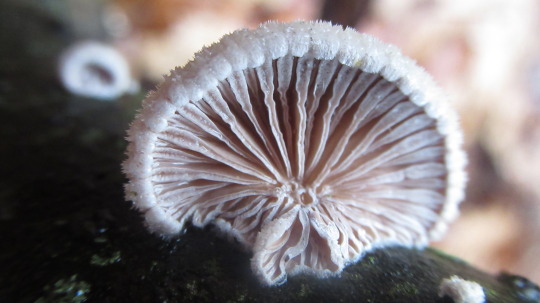
Split gill
Schizophyllum commune
Split gills were the first fungi I featured on this Tumblr.
But I’ve taken so many new pictures since then, I couldn’t resist sharing some.

This is one of my favorite species of fungi, one I find practically everywhere.

They’re easy to find. The tiny little ones can be overlooked. What a shame, because once you take a closer look, a wild and beautiful world appears.

And they can vary so much!

Wherever I find them, I’m always sure to take a closer look.
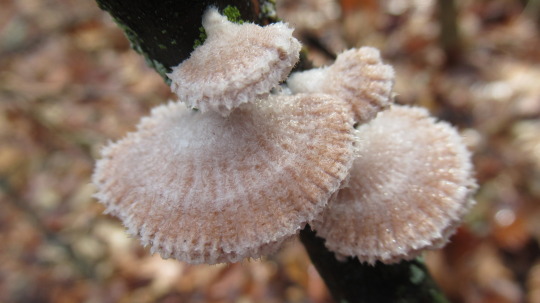
From the top, they don’t look too special.

But don’t let that fool you!
They open or close their “split gills” depending on the humidity. This way, their fruiting bodies can continue sporulating through extended dry or cold periods.

I haven’t gotten tired of them yet. Not a bit.
One of the first fungi I learned to identify, they’ll always be a special friend to me.
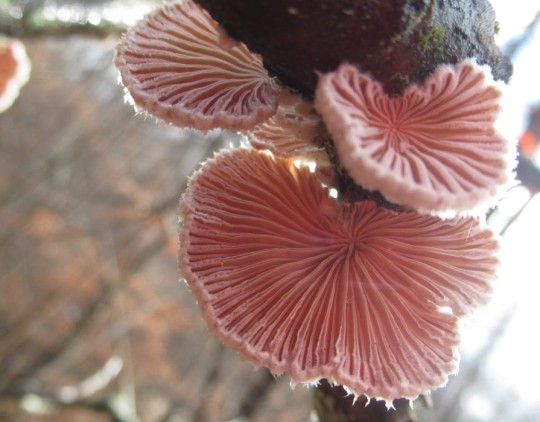
#fungi#mushrooms#mycology#biology#life#fungi photography#mushroom photography#bioart#nature#naturecore#nature photography#forest#forestcore#rot#fantastic fungi#science#mushlove#hiking#foraging
70 notes
·
View notes
Photo
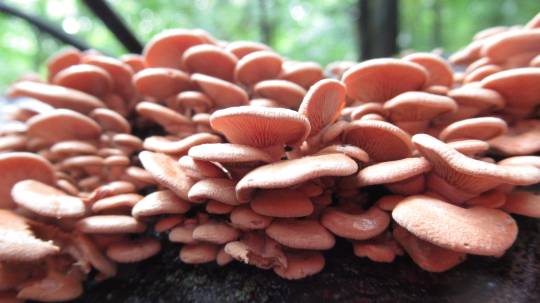
Bitter oyster
Panellus stipticus
Not truly a type of oyster mushroom, Panellus stipticus are inedible.
They’re tiny and usually easily overlooked, but these little mushrooms have pretty fun secret.
They’re bioluminescent.

Though I’ve seen bioluminescent fungi before, I’ve never had the pleasure of catching glowing Panellus specimens in the dark.
The ones I’ve photographed here were either left in the field, or simply didn’t glow when brought home for some reason.

But their gills are reported to glow brightly, producing a radiance that supposedly surpassing other similarly bioluminescent fungi like Jack O’Lanterns.

They are tiny fungi resembling common crepidopsis or similarly oyster-like fruiting bodies.
But their gills do not run decurrent down their pseudostipes. The caps attach asymmetrically to the stipe and the gills stop suddenly, marking a well defined line where the stipe meets the cap. This is a common feature for members of the Panellus genus.
They are fairly common and easy to find growing on decaying wood. I typically find them through late fall.
Once you get your hands on some, take them home and check them out in total darkness.
Good luck mushroomers!
#fungi#mushrooms#bioluminecent#biology#mycology#life#science#forest#forestcore#nature#naturecore#foraging#hiking#rot#mushlove#fantastic fungi#bioart#nature photography#mushroom photography#fungi photography
287 notes
·
View notes
Photo

Mock oyster
Phyllotopsis nidulans
It’s easiest to find these early winter beauties after a light dusting of snow. The bright orange is hard to miss.
They’re not for the kitchen foragers though, as the “mock” oyster shouldn’t be confused with typically eaten Pleurotus mushrooms.
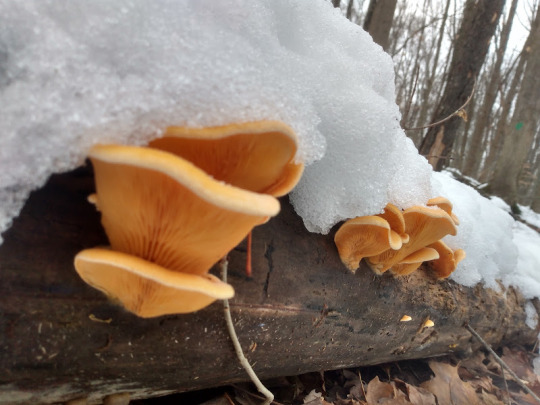
True, their gills are decurrent, running down the stalk or pseudostipe like oysters and they grow on recently dead wood like oysters. But there’s some big differences.
Their color is pretty hard to miss for one thing. They’re bright orange to salmon. And their caps are slightly hairy.

Then there’s the smell.
Mock oysters have a skunky, sulfurous smell that can by like mild skunk cabbage or harsh as rotten eggs.
So they’re not exactly coveted by hungry foragers.

Still, they’re not toxic.
Though they’re typically regarded as inedible, I saw no reason why they should be regarded as poisonous when I was curious enough one day to take some home.
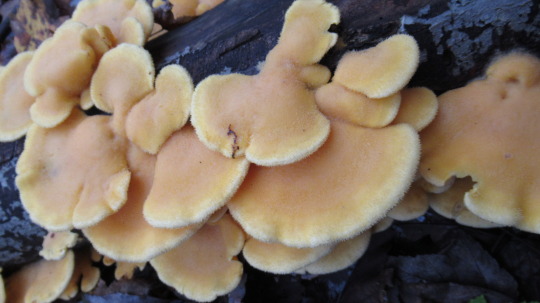
I once had a batch of some that I regarded as relatively odorless. I decided to experiment.
Please don’t follow my lead. I am a mushroom amateur, true. But I still do my research. If you want to consume similarly “inedible” or “edibility unknown” fungi for science, do so at your own peril. Always be sure you can identify your mushrooms with certainty and DO NOT MESS WITH TOXIC SPECIES.

While my concoction may not have smelled much before cooking, the stir fry I ended up with had a pungent and sulfurous flavor and scent.
In the name of science, I learned that my body will in fact tolerate a small amount of mock oyster, even if my senses reject it.
These days, I’m happy just to find and observe the fruiting bodies in nature. Though I usually can’t resist a good sniff just for fun.
#mushrooms#fungi#biology#mycology#science#foraging#winter foraging#hiking#nature#naturecore#forest#forestcore#rot#fantastic fungi#life#mushlove#sciencecore#goblincore#smelly#bioart
51 notes
·
View notes
Photo

Phlebia tremullosa
I’m a fungi amateur. No doubt about it. Mostly, I just walk around and take pictures.
I love all fungi! But over time, I’ve developed a few favorites. The genus Phlebia never fails to amaze me.

Phlebia tremullosa is one of the beautiful species this mesmerizing bunch offers. It isn’t hard to see where it gets its species name, as its fertile surface wrinkles and forks in trembling patterns.
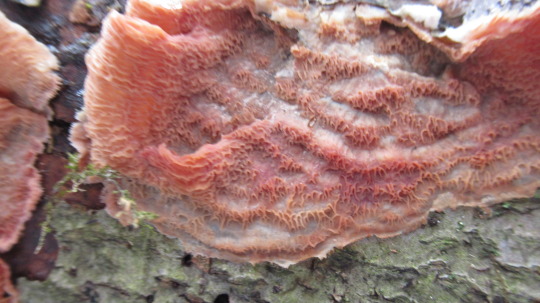
Its growth habit is called effused-reflexed. This just means that it spreads out like a crust while shelfing out at the tops.
They usually display that telltale Phlebia sunburst pink to mauve coloring, which is part of what makes them so appealing to me.
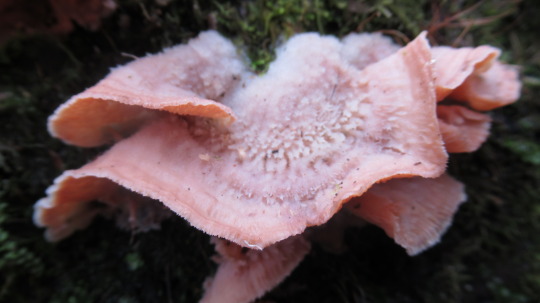
Their caps are typically lighter and often a bit wooly.
They range from fairly uninspiring...
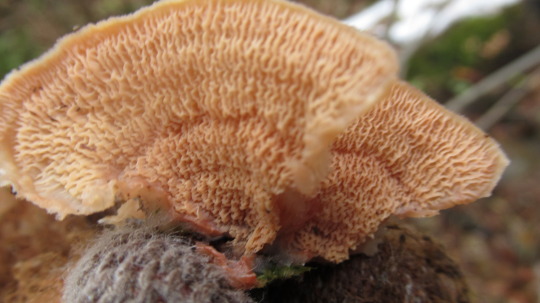
...to intricate and bizarre.

They are saprobic, meaning the fungi use dead wood as a food source.
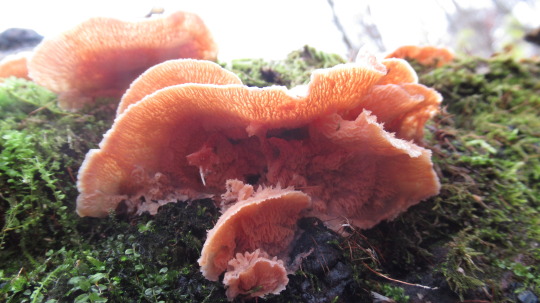
I mostly find P. tremullosa on deciduous wood in late fall through early winter.

They’re in that blurry realm where shelved, porous fungi meet spreading crusts.
Their signature “trembling” ridges and radiating wrinkles are kind of weird, so they’re obviously lovely to me

#fungi#mushrooms#crust fungi#biology#mycology#forest#life#nature#nature photography#fungi photography#mushroom photography#fantastic fungi#rot#woodlands#bioart#naturecore#forestcore#hiking#foraging
706 notes
·
View notes
Photo

LICHEN
Lichen are compound organisms. They’re communities of various species, needing each other to live as one.
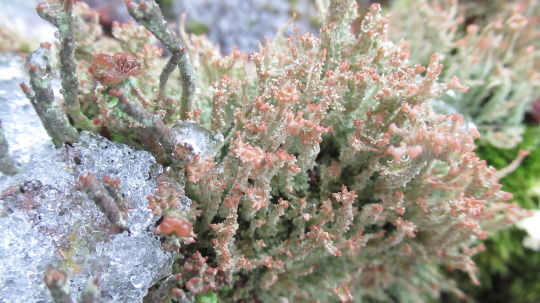
The main body of the lichen is fungal, but rather than consuming some food source, the fungi partner with a photosynthesizing biont, either algae or cyanobacteria depending on the lichen species.

Recent research shows that lichen are even weirder than people thought, having at least three symbionts or more, including a second fungi. Yeast.

They can be strangely mesmeric with their little and often colorful complexities.
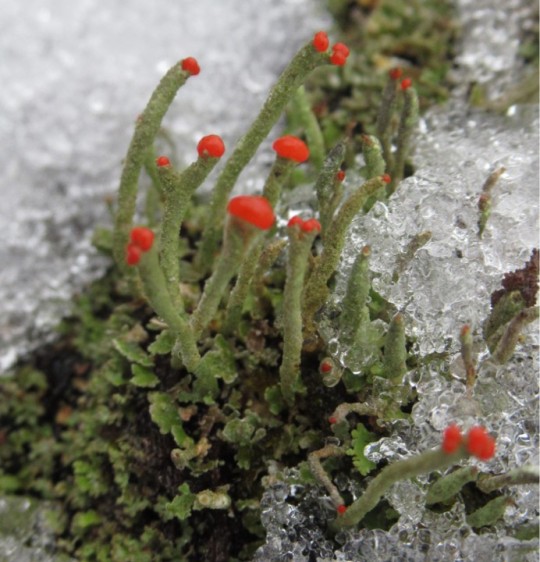
Right at home living on rocks or wood, they’re often right amongst heaps of moss or liverwort.
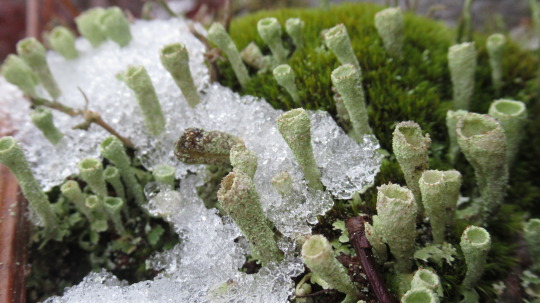
Mixed up like that, it might be easy to confuse them with plants.
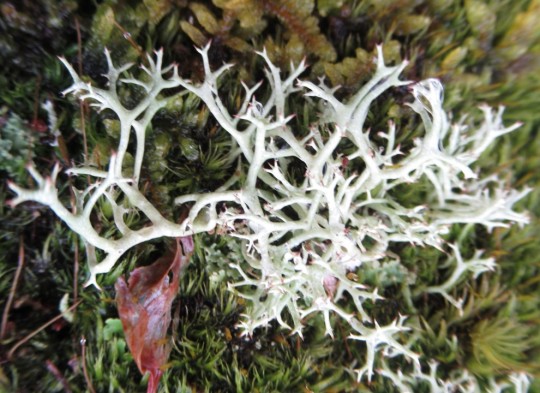
But their colors and shapes give them away. Structure can vary greatly. Shrubby, leafy, crusty or powdery.

Lichen can be found all over the world, including Antarctica, as they resist extremes in conditions.
But they are awfully vulnerable to air pollution, making them obvious indicators of air quality.
Places with greater diversity of any life really but particularly lichen are probably healthier and less polluted.
I usually photograph fungi near my home in Cleveland, but I traveled to Appalachian Pennsylvania to find these beauties all on the same walk.
Not used to this kind of access to my lichen friends, it felt to me like some kind of wonderland!
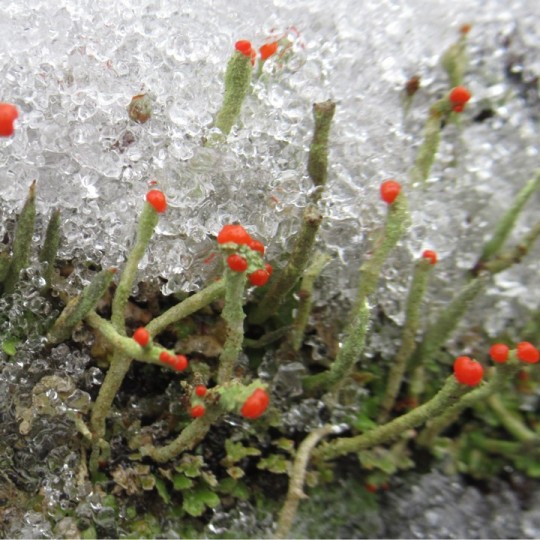
#fungi#lichen#mushrooms#fungi photography#mushroom photography#biology#mycology#lichenology#forest#forestcore#life#bioart#naturecore#nature#nature photography#hiking#fantastic fungi#mushlove
1K notes
·
View notes
Photo

Thin-maze flat polypore
Daedaleopsis confragosa
From a distance, thin-maze flat polypore looks like any common conk, shelfing out from rotting wood.

Yet their fertile surface grows in distinct fashion, making them stand out. These aren’t your typical polypores.
It just takes a closer look.
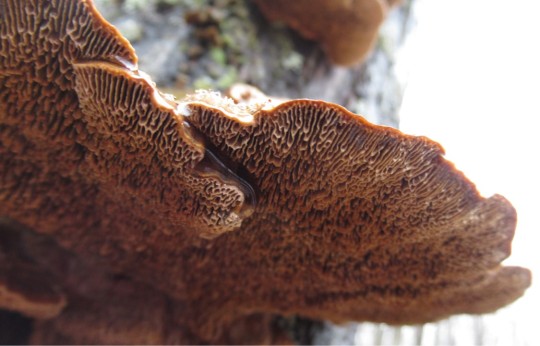
Though they vary, this particular flush I found on a day trip to PA has complex canyons and spires instead of elongated pores. They become more maze like as they fork at the margins.

They look otherworldly. reminding me of a labyrinth of notched wind chimes, slivers of bamboo, and bizarre stalactites.
I haven’t often found them like this, usually finding more typical “thin maze” structures.
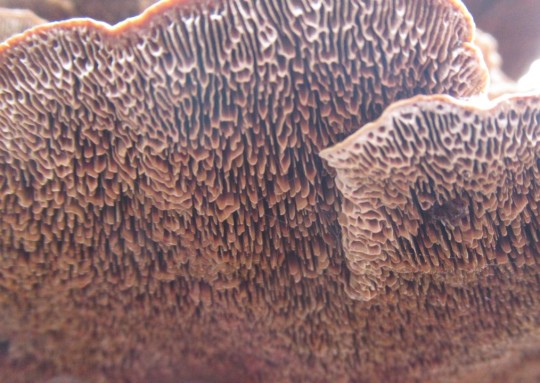
Besides concentric rings and zonate color differences, the shelves themselves are fairly indistinct.

Just look at them from a different angle, and their beauty is undeniable.

#fungi#mushrooms#mushroom photography#fungi photography#nature#nature photography#naturecore#forestcore#forest#hiking#biology#mycology#polypores#life#foraging#mushlove#bioart#fantastic fungi
440 notes
·
View notes
Photo

Birch Polypore
Fomitopsis betulina
Birch is not common in Ohio, though I have come across the occasional birch polypore on what little birch we have, I’ve had much better luck finding them in birch groves though neighboring states.
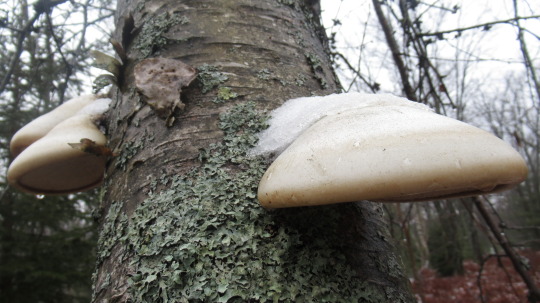
Birch polypore is pretty distinctive as the edges of the shelf’s cap roll around its strange, almost toothy fertile pore surface.

This particular polypore species produces fruiting bodies which only spore through one year. making them annual polypores.

I think there’s an odd beauty in them, much like birch forests altogether. When mushrooming is slowing down in winter, Birch polypore can provide much needed relief for fungal fanatics.
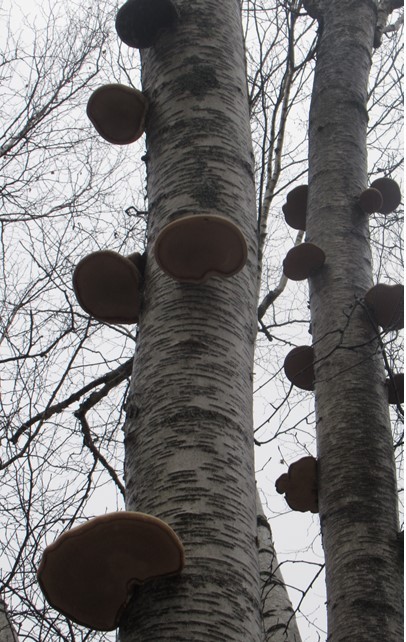
#fungi#mushrooms#foraging#hiking#woodlands#forest#forestcore#nature#nature photography#mushroom photography#naturecore#biology#mycology#fantastic fungi#polypores#birch#mushlove
355 notes
·
View notes
Photo

Winter mushrooming?
Okay, so winter is hitting me hard right about now as a mushroomer.
It’s almost February, and we’ve been getting hit with daily snow and temps well below freezing.
I have not been out much to find mushrooms.
That doesn’t mean there isn’t fungal activity, even now. During warmer thaws, there are still some chances to take in a variety of perennial polypores, crusts, lichen, and even occasional flushes of fleshy, gilled mushrooms.

Velvet foot, for example. Flammulina velutipes.
Their dark brown fuzzy stipes, creamy gills, white spore print, and flame like caps are distinctive, but beginners may still confuse them for deadly poisonous Galerina. So be very careful with these if you plan on cooking with them.
Mushrooms are great and all. But nobody needs to risk their lives over a pretty decent omelet. If you aren’t absolutely sure what you’ve got, do not eat it.

Brick caps, Hypholoma lateritium, are another delicious winter edible, but there are toxic Hypholoma cousins, so this is another one to be careful with.
But brick caps are out of season by now, as they come up only in early winter.
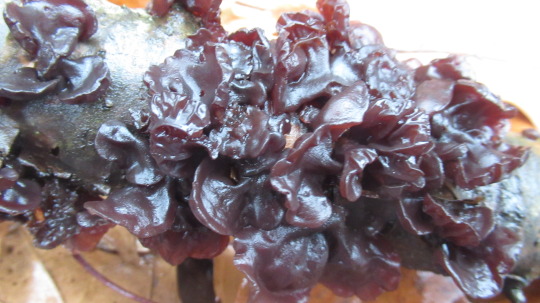
Amber jelly roll can be found throughout the winter though. Jelly fungi aren’t exactly the tastiest, but I’ve recently started drying, grinding and rehydrating them with blended fruit to make jam.
Over the next couple months, my fungi finds might not be as diverse as through warmer months, but I have no intention of staying indoors until Morel season.
Well, maybe for a bit longer. I’ve got enough amber jelly to last until the next thaw.
#fungi#mushrooms#foraging#hiking#winter#winter foraging#nature#nature photography#fungi photography#mushroom photography#fantastic fungi#forest#forestcore#life#biology#mycology
185 notes
·
View notes
Photo

Greenbacks
Panellus serotinus
Often called the late fall oyster, I find Panellus serotinus from November into early winter.
They are a good edible mushroom.
Thanks to greenbacks, I can’t understand for the life of me why anyone would give up their mushrooming for the year just because it got a little cold.

They look similar to common oysters, but have somewhat golden gills and green or muddy purple caps. Their texture tends to be a bit rubbery, so they need a few more minutes cooking than oysters do.

They can also be distinguished from oysters by the way their gills stop at almost a perfect line along the pseudo stipe.
I find these by the heaps! It’s been an incredible year so far.
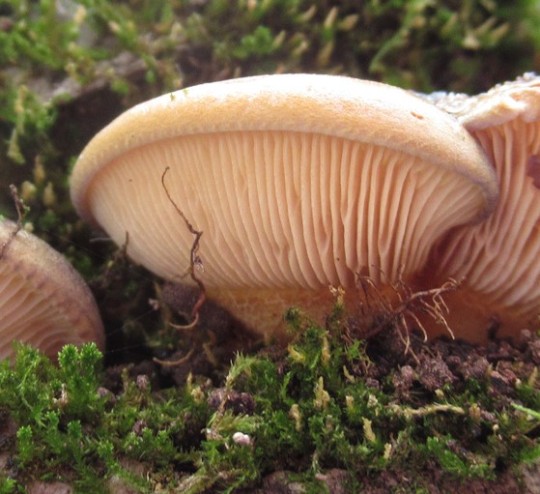
#fungi#mushrooms#mushroom photography#fantastic fungi#rot#forest#forestcore#nature photography#nature#fungus#winter foraging#foraging#winter#fall#autumn#life#naturecore#mushroomcore#mushroom hunting#hiking#wild edibles#wild food#mushrooming#mush love
159 notes
·
View notes
Photo
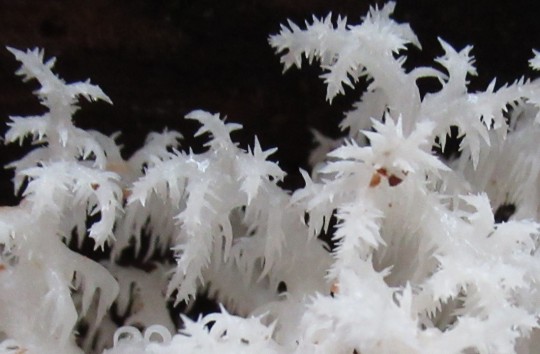
Comb tooth Hericium
Hericium coralloides
December snowflakes on a dark winter’s night?
Not quite.
Watching snowflakes melt on my windshield, I couldn’t help but think, as usual, about fungi.
The comb tooth or coral tooth Hericium is a delicate lacework fruiting body with remarkably crystallin growth habits.
I found this one in November.

Their fruiting bodies emerge throughout autumn and are good edibles along with other Hericium species. Their crablike taste and texture makes them especially sought after by hungry mushroomers.
The first I ever laid eyes on one was at foray with Ohio Mushroom Society. I’d spent the day looking for Hericium with no luck at all. Members were looking over our haul when Walt Sturgeon, a local mycologist, made an appearance with Hericium coralloides cradled in his hands. He’d only just joined us, but said he’d found it off the road on his way to the parking lot.
Since then, I’ve had a little more luck of my own.

Though comb tooths aren’t the heftiest of Hericiums for the kitchen, they can still show off their beautiful snowy white feathers and soft coral branches for anyone willing to look.
#mushrooms#fungi#fungus#mushroom photography#nature#naturecore#nature photography#fungi photography#hericium#forest#forestcore#hiking#foraging#fall#autumn#life#biology#mycology#snowflakes#mushlove#rot#bioart
203 notes
·
View notes
Photo


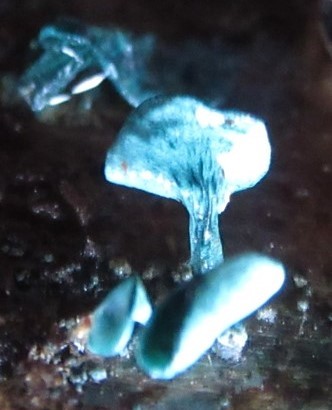
Wood-stain elf cups
Chlorociboria species
Look like scenes from an alien planet?
Nope. Just another beauty from the kingdom Fungi.

I have rarely seen the fruiting bodies of Chlorociboria. Just once before this past weekend.
Lucky me to find a wonderland full of them!
This was my first time photographing their little cups.
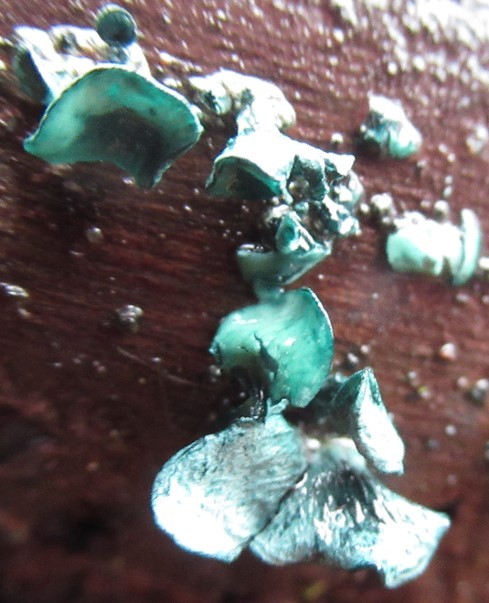
The colors are just gorgeous. No editing needed to reveal its true beauty.
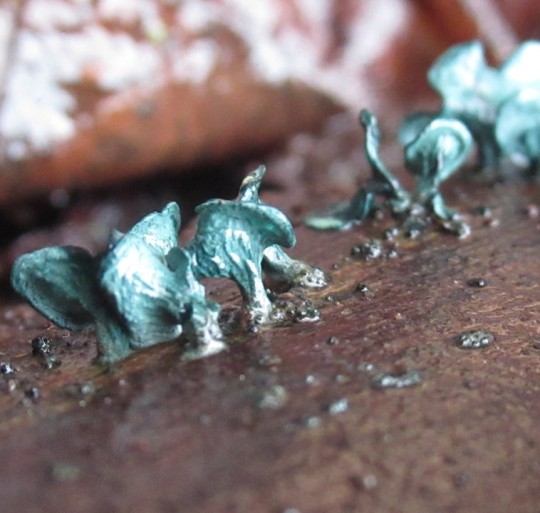
Chlorociboria are saprobic, feeding on decaying wood. Their spore-releasing apothesia are brilliantly colored electric teal.

The fungi produce xylindein, a blue-green pigment which stains its wood substrate.

The blue stained oak is prized in woodworking, and its use in Tunbridge ware and parquetry is centuries old.


The little cups are easy to miss if you’re not paying attention, but they’re fairly common and widespread.
A secret magic world, hidden in the rot!
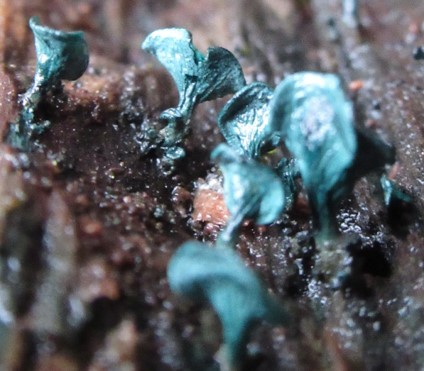
#fungi#mushrooms#fairies#fairycore#nature#nature photography#mushroom photography#mushlove#fantastic fungi#forest#forestcore#life#biology#mycology#woodworking#hiking#foraging#winter foraging#planet earth#mushroom hunting#rot#wood
236 notes
·
View notes
Photo

Brick caps
Hypholoma lateritium
When the nights are long and the days are snowy, mushrooming can be a challenge.
Luckily, there’s still plenty of fungi to find.
Brick caps are among my favorite edible mushrooms in early winter. They have a real pleasant nutty flavor, so I can’t get enough of them.
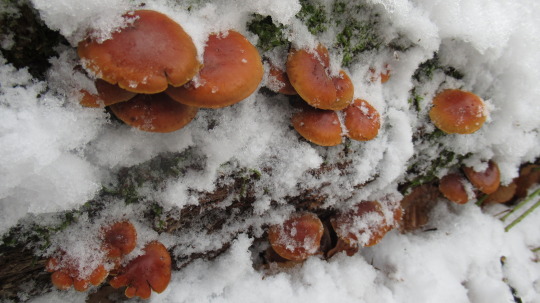
Brick caps will start showing up in late fall, but will continue into early winter. Sometimes, I’ll even find them buried under snow. These were hardly visible before I brushed the log off.

Their reddish two-toned caps and stipes give them away, though they’re sometimes pinkish when they first start out. Adorable, right?
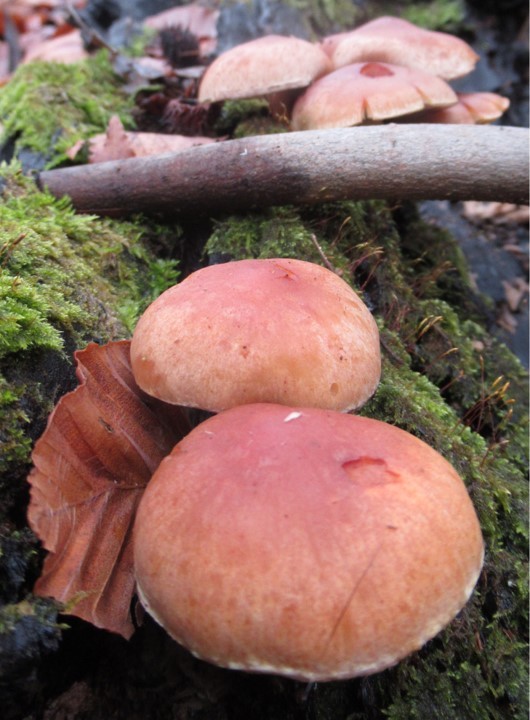
They’ll darken to brick red, often cracking at the caps.
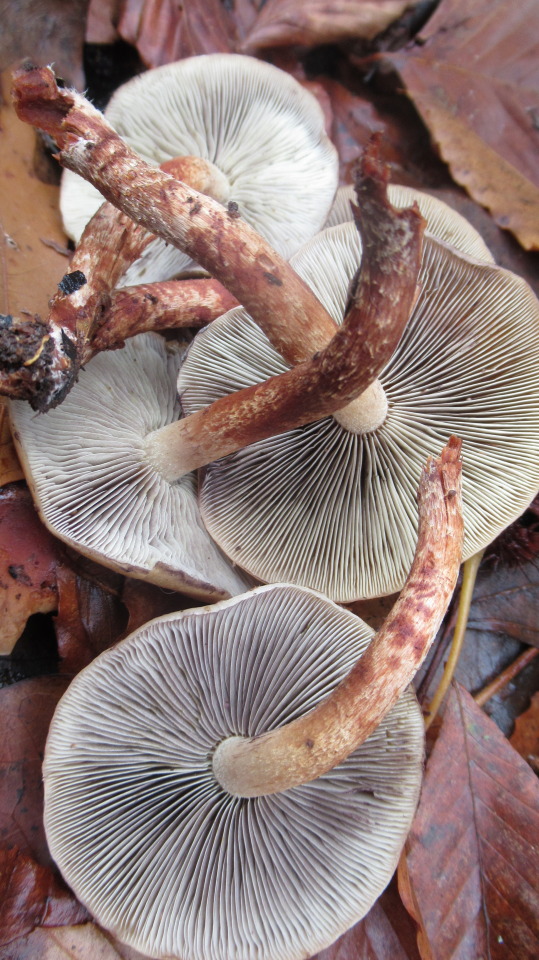
The gills are smoky, a tell-tale sign of the hyphaloma genus. Beware though. They have toxic look-a-likes including their greenish-gilled cousins, sufur tuft hyphaloma fasciculare.
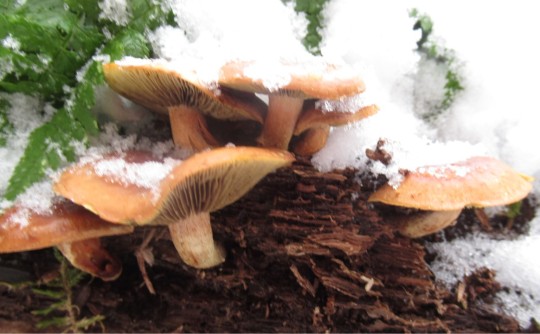
#fungi#fantastic fungi#foraging#winter foraging#mycology#hiking#forest#forestcore#nature#naturecore#nature photography#mushroom photography#life#biology#fungus#dirtcore#rot#woodlands
378 notes
·
View notes
Photo
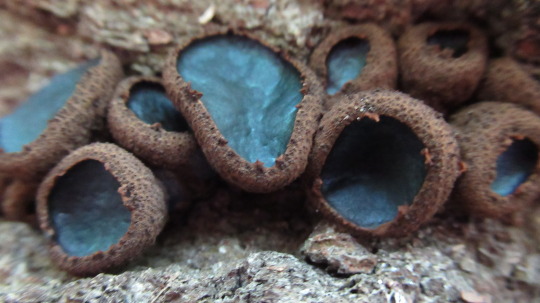
Black jelly drops
Bulgaria inquinans
Why are these iridescent sapphire cup fungi called black jelly drops?
The fruiting bodies of fungi can change as they mature.
They’re hardly noticeable when tiny and just peaking out from cracks in dead wood.
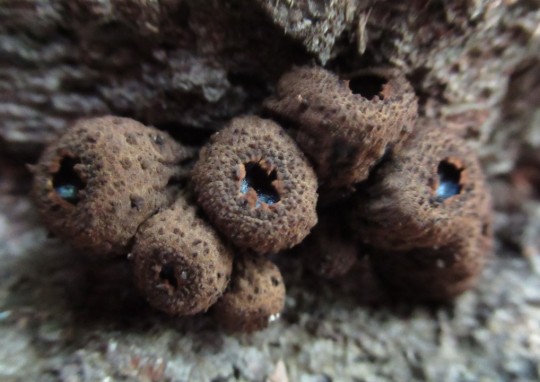
They’ll open into cups.

And can be quite pretty. Just look at that color!
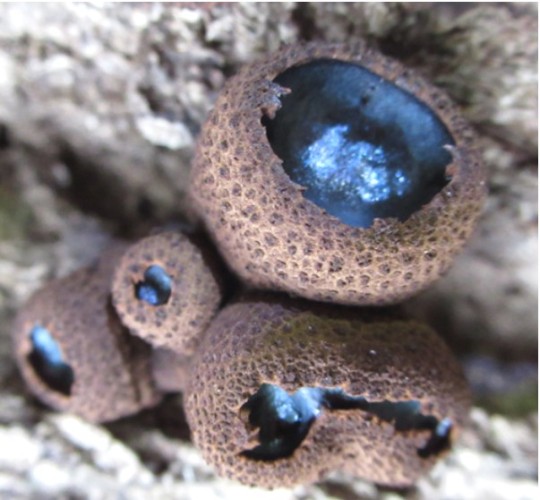
They’ll soon flatten into disks
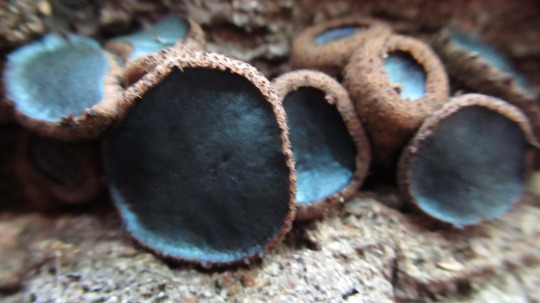
then darken to appear more like suction cups on tentacles than shining gems.
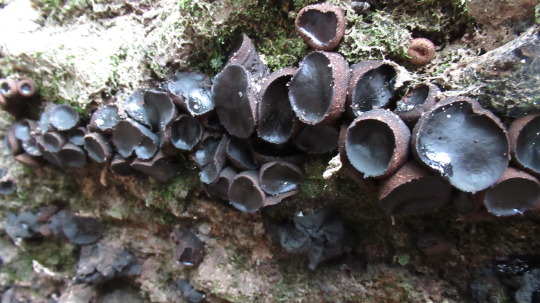
Their scaly, tan exteriors turn black and wrinkle into cones. Like little witch’s cauldrons.

At last, they look like woodland licorice jelly drops. What a transformation!



#fungi#mushrooms#biology#life#mycology#hiking#forest#nature#naturecore#nature photography#mushroom photography#fungus#woodlands#forestcore#mushroom#mushroomcore#goblincore#fairycore#witchy#rot#foraging#wildlife#outdoors#mushlove
1K notes
·
View notes
Photo

Winter oyster
Pleurotus ostreatus
Mushrooming in December is easier than you’d think.
There’s still plenty of fungal diversity to be found and though it may feel like winter around Cleveland, where I live, the late fall mushrooms are still out.
Still, things are starting to slow down as snow becomes increasingly common and temperature continues to drop.
Though it’s certainly not the only reason I love fungi, bringing home edible mushrooms for the kitchen isn’t in it’s peak season right now.
Oh, but the time for just a few edible mushrooms is only just beginning!
Take winter oysters for example. There’s plenty of young ones out now, just starting to grow.
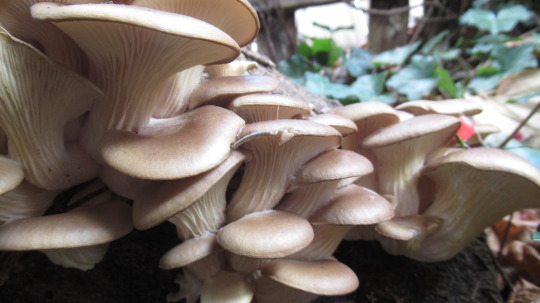
The other day, I saw a huge fruiting of winter oysters driving past a random yard and was severely tempted to trespass just to nab them.
What amazing luck I had, though, when I found more right by own driveway arriving home again.
They’ll be showing up all through winter and into spring.
Truly, there is no “off-season” with mushrooms. Maybe a “less-season,” but it never really stops.
#fungi#fungi photography#mushrooms#mycology#biology#forest#rot#mushroom#fungus#forestcore#woodlands#life#nature#naturecore#nature biography#foraging#forage#hike#outdoors#harvest#wild eats#mushlove
277 notes
·
View notes
Photo

Resinous polypore
Ischnoderma resinosum
Fall is my favorite season for mushrooming.
This year, I started photographing and cooking resinous polypore at October’s end.
What a shocking find this was on a massive beech.
They are called “resinous” polypore as they’ll often exude a golden guttation, sweating excess fluid from the polypores.

They almost look like they’re dripping with honey. The “resin” is their species namesake, resinosum.

This fungi is mostly saprobic, feeding on dead wood, though they’ll sometimes finish off a dying tree as parasites. Their polypore fruiting bodies often have an extending, lobular growth encrusting the tree’s surface before shelfing.
I dry pan the tender parts like beef and eat them with steak sauce. They can have a nice texture with a wonderful savory taste when collected and cooked right.

They practically explode in the autumn, appearing everywhere wood rots and growing rather quickly.
By December, most will be fairly tough and dry, but even then I’ll find a few young ones.
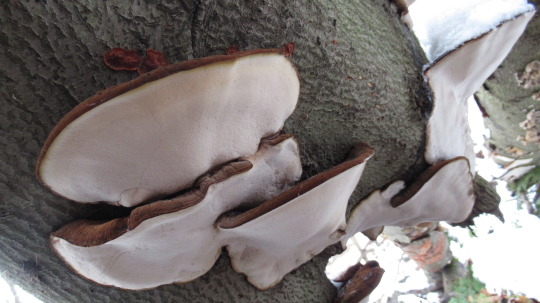
Truly a beautiful fungal fruiting body, adding of course to nature’s fall delights.
#fungi#mushrooms#autumn#fall#spooky season#mushroom hunting#foraging#hiking#nature#forest#woodlands#nature photography#biology#mycology#mushroom#fungus#forestcore#naturecore#fantastic fungi#rot#life#mushlove#polypores#trees#winter foraging
473 notes
·
View notes